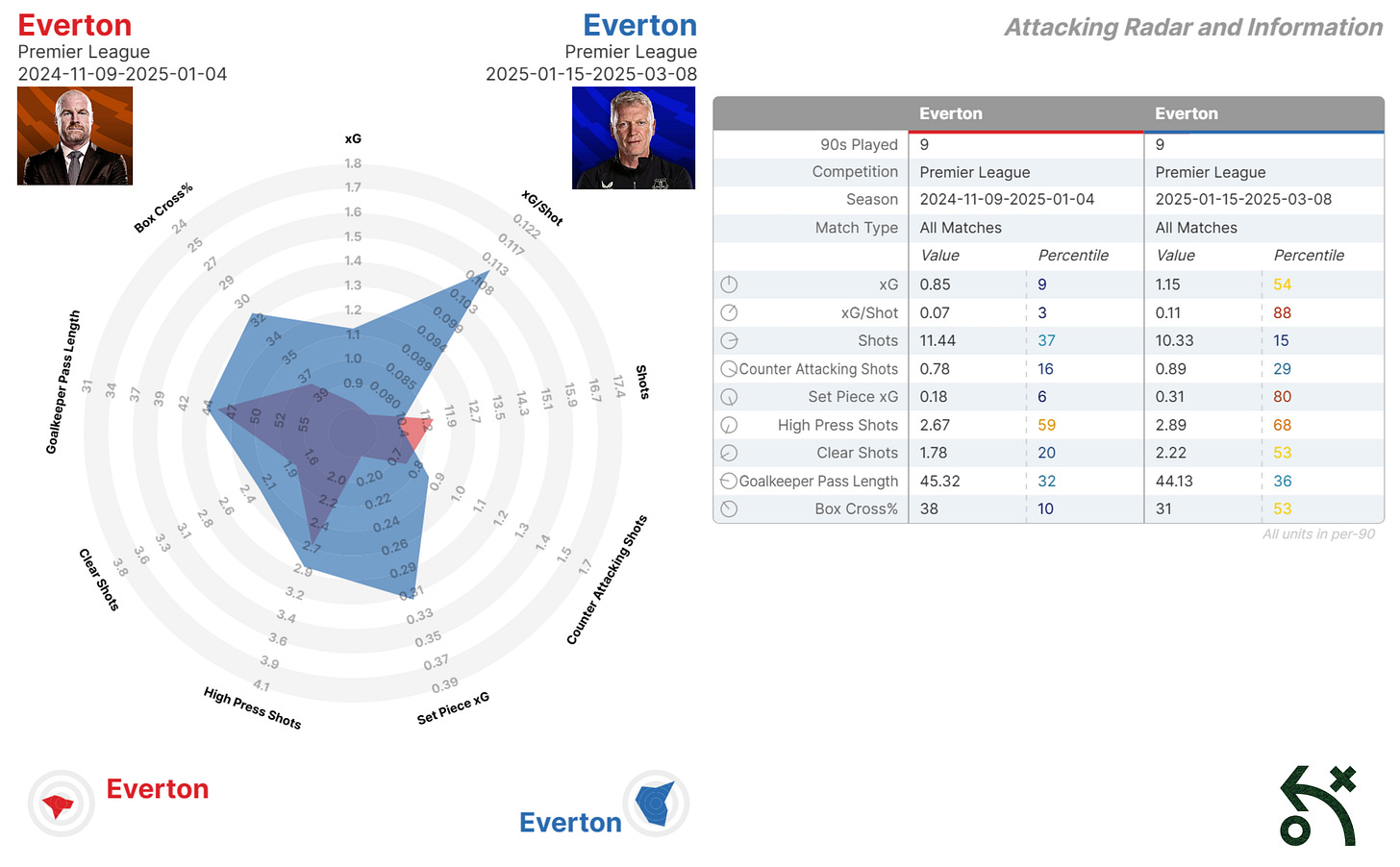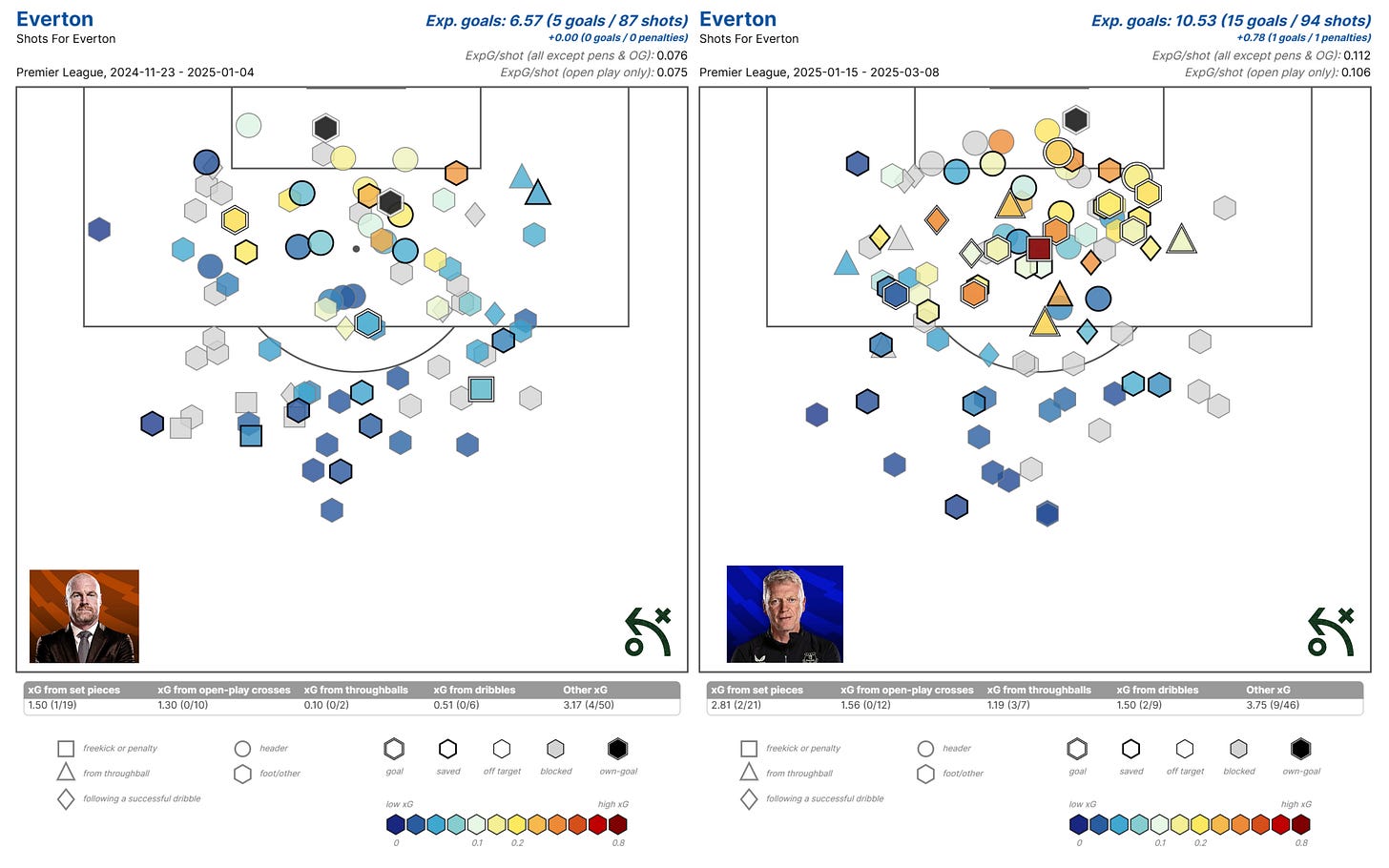In Moyes We Trust
How David Moyes has revived Everton’s defensive resilience - but can he unlock their attacking potential?
In December 2024, The Friedkin Group (TFG) completed their acquisition of a majority stake in Everton FC, marking the end of the turbulent Moshiri era - a period many Evertonians were eager to leave behind. With TFG also owning Serie A giants AS Roma, their management style in Italy offers clues as to how they might shape Everton’s future. Over in Rome, they’ve shown a willingness to make bold decisions, cycling through five managers since 2020. While some of those choices were questionable, they did deliver silverware, with Roma lifting the 2022-23 Europa League under Jose Mourinho.
With Everton staring down a third consecutive relegation battle, TFG wasted no time in making their first big decision - changing the manager. The club needed a steady hand, someone who could bring structure, discipline and experience.
Enter David Moyes.
Having left West Ham United at the end of last season, the Scotsman was synonymous with Everton’s past success, consistently pushing them into the European spots during his first spell. More recently, he guided West Ham to European glory, winning the Europa Conference League in 2023.
Now, in his second stint at Goodison Park, Moyes is proving his worth once again. Now nine games unbeaten, Everton are climbing the table and rediscovering their identity as a difficult team to beat.
But what exactly has changed? To find out, we dive into the data, comparing Moyes’ impact to Sean Dyche’s tenure.
Everton’s Tactical Shift: What the Data Says
The xG trendline, based on a 10-game rolling average, provides a clear statistical reflection of Everton’s transformation under Moyes since Dyche’s departure With a nine-game unbeaten streak, Moyes has undeniably improved the team’s defensive structure, but the attack remains a work in progress.
Defensive Improvements: A More Resilient Everton
Under Dyche, Everton’s xG conceded (purple line) was consistently high, averaging around 1.5 to 1.7 per match, making them one of the most vulnerable sides in the league.
The trendline post-Moyes’ appointment shows a sharp decline in xG conceded, stabilizing closer to 1.0 per game.
This defensive tightening correlates directly with the team’s unbeaten run, in other words - Everton has become much harder to break down.
Attacking Output: Some Growth, But Not Enough
Everton’s xG (green line) under Dyche was erratic, fluctuating between 0.7 and 1.2, showing a lack of sustained attacking strategy.
Since Moyes took charge, xG has been steadier, with a slight upward trend. While this suggests improved attacking structure, the numbers remain low, indicating that Everton is still struggling to create high-quality chances.
The xG gap between attack and defense has tightened, meaning that Everton is no longer giving away more than they generate - but they are still not a prolific attacking side.
The Impact of the Managerial Change
The blue vertical line marks the transition from Dyche to Moyes. Before this, xG conceded was trending dangerously upwards, while xG remained inconsistent.
Post-Moyes, the defensive trend sharply improves, while xG remains steady but unspectacular.
The dashed trendlines further reinforce this shift: Everton is now defensively solid but still searching for an attacking breakthrough.
Love deep-dive football analysis? Subscribe to Trutactics for exclusive scouting reports, tactical insights, and in-depth breakdowns - all for free!
Don’t miss out - hit the button below and share it with fellow football fans!
Tactical Approach
Since David Moyes returned to Everton in January, the team has transformed from a side struggling with predictability and attacking inefficiency under Sean Dyche to an outfit that is now more structured, harder to beat, and enjoying a nine-game unbeaten run. But while Moyes has undoubtedly improved Everton’s organization, as we see from the trendline analysis, their final-third struggles persist - and that may define their ceiling for the rest of the season.
Tactical Structure: More Control, But Still a Work in Progress
Looking at Everton’s passing network from their 0-2 loss to Nottingham Forest under Dyche and their 1-1 draw with Wolves under Moyes, the changes in tactical structure are clear.
Let’s analyse and compare both systems.
Dyche’s Everton (Loss vs. Nottingham Forest, 0-2)
Rigid, predictable shape, with minimal central progression.
Heavy reliance on full-backs (Mykolenko & Young) to push forward.
Armando Broja isolated up front, receiving little service.
Defensive passing connections, particularly between Tarkowski and Branthwaite, slowed transitions.
Moyes’ Everton (Draw vs. Wolves, 1-1)
More compact midfield, with better passing links through Garner, Gueye, and Doucouré.
Right-sided build-up preference (Lindstrøm & O’Brien more involved), with both wing backs causing more problems for opposition, shown in their on-ball value (OBV)
Structured possession, but final-third penetration still lacking.
Beto remains isolated, though midfield is more involved in build-up.
The difference is clear: Moyes has given Everton more control and stability, but they are still struggling to fully connect midfield to attack.
Passing & Ball Progression: Faster, But Not Yet Fluid
Under Dyche, Everton’s passing was slow, predictable, and centered around defensive recycling rather than purposeful progression. Tarkowski’s passing volume in the Forest loss exemplified a system that valued safety over risk taking.
Moyes has changed that. Everton now has more structure in possession, a better midfield shape, and more distribution through central players. However, the over-reliance on wide areas remains, and they still lack consistent vertical penetration to trouble deep-lying defenses.
Striker Isolation: The Persistent Issue
Perhaps the biggest issue that has persisted between both managers is striker isolation. Whether it was Broja under Dyche or Beto under Moyes, Everton’s lone striker has remained isolated, lacking consistent service
Dyche’s Everton: Minimal central play, heavy reliance on crosses.
Moyes’ Everton: More structured but still struggles to link midfield to attack.
Moyes has improved passing circulation and midfield connectivity, but without more aggressive, risk-taking passes into the final third, Everton will struggle to turn their solidity into consistent goals.
Overall Comparison & Conclusion
Moyes has undoubtedly made Everton more difficult to break down, and the nine-game unbeaten run is a testament to his ability to create a more organized and efficient system. However, attacking fluidity remains the missing piece. If Everton can find a way to better integrate Beto into their build-up and introduce more vertical passing sequences, they can push for higher league positions by winning matches, rather than just avoiding defeat.
The next step?
Transforming defensive solidity into attacking efficiency. If Moyes can strike the right balance, Everton won’t just be hard to beat - they could become a genuine force once again competing for European places.
Now, let’s dive into the defensive data to see just how much Everton has improved under Moyes.
Defensive Data: Improvements under Moyes
The defensive radar and statistical breakdown further reinforce how David Moyes has drastically improved Everton’s defensive structure. Under Sean Dyche, Everton conceded too many shots (13.11 per game) and clear-cut chances (3.00 per game), with an xG conceded per 90 of 1.16 - a worrying figure that placed them in the mid-table range defensively. Since Moyes took over, Everton’s xG conceded has dropped to 0.88, with fewer shots conceded (11.33 per game) and significantly fewer clear shots allowed (1.78 per game). This shift has made Everton one of the league’s most resilient defensive teams, reflected in their recent unbeaten run.
Beyond just reducing shots, Moyes has instilled a more compact, disciplined defensive approach. The team is now slightly more aggressive in duels (85th percentile) and better at preventing counter-attacking shots (down from 1.00 to 0.56 per game). However, one area that has worsened under Moyes is set-piece defending, with xG conceded from dead-ball situations increasing from 0.22 to 0.33 per 90. While Everton is harder to break down in open play, set-piece vulnerability remains a concern. This explains why Charlie Adam has recently been brought in as the club’s set-piece coach, with the goal of tightening up their set-piece defence and improving these numbers.
However, Everton’s attacking struggles remain a concern. Let’s analyse the data to understand where they’re falling short and what needs to change.
Attacking Data: Signs of Progress, But Challenges Remain
While David Moyes has clearly improved Everton’s defensive structure, this attacking radar suggests that offensive improvements remain marginal. Under Sean Dyche, Everton’s attacking numbers were among the league’s worst, averaging just 0.85 xG per 90 (9th percentile), with poor shot quality (xG per shot: 0.07, 3rd percentile) and minimal threat from counter-attacks. Since Moyes took over, Everton’s xG has risen to 1.15 per 90 (54th percentile), while xG per shot has significantly improved (0.11, 88th percentile). However, overall shot volume has actually decreased from 11.44 to 10.33 per game, indicating a more selective but not necessarily more dangerous attack.
The shot map comparison further highlights this shift. Under Dyche, Everton registered 6.57 xG (5 goals) from 87 shots, with most attempts coming from low-xG positions outside the box or from poor angles. There was a lack of central penetration, with very few high-quality chances inside the six-yard box. Under Moyes, Everton’s xG has jumped to 10.53 (15 goals) from 94 shots, showing that while shot volume is similar, chance quality has improved significantly. There is greater variety in shot types, including more xG from through balls (1.19 vs. 0.03) and dribbles (1.50 vs. 0.51), indicating a more dynamic attack. Additionally, set-piece xG has nearly doubled (2.81 vs. 1.50), reinforcing the earlier observation that Moyes has made Everton far more effective from dead-ball situations.
The overall picture?
Moyes has made Everton more efficient in front of goal, but the attack is still a work in progress. The team is creating fewer shots overall, but they are of higher quality - a positive shift, but not yet enough to turn Everton into a consistently dangerous attacking side. To move forward, Moyes must find a way to increase volume without sacrificing efficiency.
Conclusion: Building on Moyes’ Foundation
David Moyes has undoubtedly reshaped Everton, turning them from a defensively fragile and predictable side under Sean Dyche into one that is structured, resilient, and difficult to beat. His impact is clear - Everton’s defensive numbers have improved significantly, leading to a nine-game unbeaten run, and they now concede far fewer high-quality chances. However, their attacking struggles remain, and the data suggests that while Everton is now more efficient in front of goal, they still lack volume and penetration in the final third.
With Carlos Alcaraz being the only new arrival, Moyes has relied entirely on tactical adjustments rather than new personnel. While this highlights his coaching ability, it also raises questions - how much more could Everton improve if properly backed in the transfer market? A proven goalscorer or a creative playmaker could be the missing piece in turning this team from hard to beat into a genuine attacking force.
Looking ahead, Everton’s move to their new home at Bramley-Moore Dock Stadium marks the beginning of an exciting new era. A modern stadium, a more stable defensive unit, and the right recruitment could signal a fresh start both on and off the pitch.
If Moyes can maintain this defensive solidity while unlocking greater attacking fluidity, Everton won’t just be avoiding relegation - they could be laying the groundwork for a return to the top half of the table and beyond.
The foundation is there. Now, can Moyes build on it?











